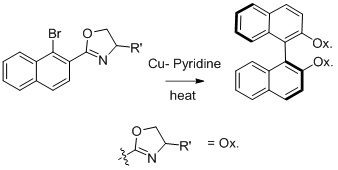Ullmann reaction
| Ullmann reaction | |
|---|---|
| Named after | Fritz Ullmann |
| Reaction type | Coupling reaction |
| Identifiers | |
| Organic Chemistry Portal | ullmann-reaction |
| RSC ontology ID | RXNO:0000040 |
The Ullmann reaction or Ullmann coupling is a coupling reaction between aryl halides and copper.[1] The reaction is named after Fritz Ullmann.[2]

Mechanism
The mechanism of the Ullmann reaction is extensively studied. Complications arise because the reactions are often heterogeneous, especially those starting with metallic copper. Radical intermediates are not observed by Electron spin resonance. Oxidative addition/reductive elimination sequence seem likely, but perhaps in one-electron steps in some cases. Copper(III) has been rarely observed but is increasingly invoked in this area of catalysis.[3] Initial organocopper intermediates are speculated to be the copper(I) species ArCu and CuX or the copper(II) species ArCuX (other ligands omitted).[4]
Scope
A typical example of classic Ullmann biaryl coupling is the conversion of ortho-chloronitrobenzene into 2,2'-dinitrobiphenyl with a copper - bronze alloy.[5][6]

The traditional version of the Ullmann reaction requires harsh reaction conditions, and the reaction has a reputation for erratic yields. Because of these problems many improvements and alternative procedures have been introduced.[7][8]
The classical Ullmann reaction is limited to electron deficient aryl halides and requires harsh reaction conditions. Modern variants of the Ullman reaction employing palladium and nickel have widened the substrate scope of the reaction and rendered reaction conditions more mild. Yields are generally still moderate, however.[4] In organic synthesis this reaction is often replaced by palladium coupling reactions such as the Heck reaction, the Hiyama coupling, and the Sonogashira coupling.
Biphenylenes had been obtained before with reasonable yields using 2,2-diiodobiphenyl or 2,2-diiodobiphenylonium ion as starting material.
Closure of 5-membered ring are more favorable more facile, but larger rings have also been made using this approach.
Unsymmetric and asymmetric couplings
Ullmann synthesis of biaryl compounds can be used to generate chiral products from chiral reactants.[9] Nelson and collaborators worked on the synthesis of asymmetric biaryl compounds and obtained the thermodynamically controlled product.[9]
The diastereometric ratio of the products is enhanced with bulkier R groups in the auxiliary oxazoline group.
Unsymmetrical Ullmann reactions are rarely pursued but have been achieved when one of the two coupling components is in excess.[8]
See also
- Copper(I)-thiophene-2-carboxylate, a copper reagent used in the Ullmann reaction
- Wurtz-Fittig reaction, a similar reaction useful for alkylbenzenes synthesis
References
- ^ P.E. Fanta (1974). "The Ullmann Synthesis of Biaryls". Synthesis. 1974: 9–21. doi:10.1055/s-1974-23219.
- ^ F. Ullmann; Jean Bielecki (1901). "Ueber Synthesen in der Biphenylreihe". Chemische Berichte. 34 (2): 2174–2185. doi:10.1002/cber.190103402141.
- ^ Hartwig, J. F. Organotransition Metal Chemistry, from Bonding to Catalysis; University Science Books: New York, 2010. ISBN 1-891389-53-X
- ^ a b Nelson, T. D.; Crouch, R. D. (2004). "Cu, Ni, and Pd Mediated Homocoupling Reactions in Biaryl Syntheses: The Ullmann Reaction". Org. React. 63: 265. doi:10.1002/0471264180.or063.03.
- ^ "2,2'-Dinitrobiphenyl". Org. Synth. 20: 45. 1940. doi:10.15227/orgsyn.020.0045.
{{cite journal}}: Unknown parameter|authors=ignored (help) - ^ Fanta, P.E. (1974). "The Ullmann Synthesis of Biaryls". Synthesis. 1974: 9–21. doi:10.1055/s-1974-23219.
- ^ Beletkaya, I.P.; Cheprakov, A.V. (2004). "Copper in Cross Coupling Reactions: The Post Ullman Chemistry". Coord. Chem. Rev. 248: 2337–2364. doi:10.1016/j.ccr.2004.09.014.
- ^ a b J. Hassan; M. Sevignon; C. Gozzi; E. Schulz; M. Lemaire (2002). "Aryl-Aryl Bond Formation One Century after the Discovery of the Ullmann Reaction". Chemical Reviews. 102 (5): 1359–1470. doi:10.1021/cr000664r. PMID 11996540.
- ^ a b Nelson, T.D.; Meyers, A.I. (1994). "The asymmetric Ullman reaction, 2. The synthesis of enantiomerically pure C2-Symmetric Binaphtyls". J. Org. Chem. 59: 2655–2658. doi:10.1021/jo00088a066.




